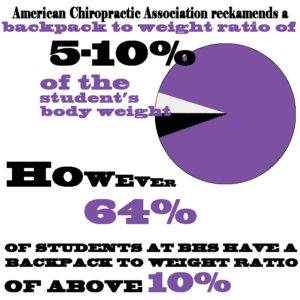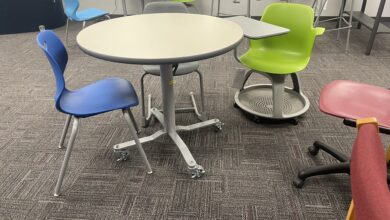
Teenagers are often described as having the weight of the world on their shoulders; they have assignments to complete and choices to make that will affect the rest of their lives, but they have another weight on their shoulders: overweight backpacks.
As Buffalo students sign up for more core classes such as English, History, Science, and Math to complete their graduation credits, they are also signing up for more and heavier textbooks to carry around. Many students have at least one textbook weighing over five pounds, plus all of their school supplies and daily necessities in their backpack, which they lug around all day to and from their classes. If students try to cram too much into their backpack or wear their backpack in a way that is unintended, it can actually cause physical damage to the body. “At least once per month we have a student come down to the health office complaining of back pain,” said school nurse, Karen Schultz. This pain may even end up sending you to a physical therapist or chiropractor.

The Effect of Heavy BackJared Schultz | Hoofprint.netpacks on the Body
Overweight backpacks can distort the natural curvature of the back, causing muscle and joint strain. Teen’s Health says, “When you put a heavy weight on your shoulders in the wrong way, the weight’s force can pull you backward. To compensate, you may bend forward at the hips or arch your back. This can cause your spine to compress unnaturally.” However, it’s not all about being overweight. Many students use backpacks incorrectly by only wearing it by one of the straps, causing one side of the body to be forced to compensate for the other. This can ruin your posture, and over time you can develop lower and upper back strain. Backpacks can also get on your nerves – literally – when they aren’t made correctly. Tight, narrow straps can dig into your shoulders, pinching nerves and cutting off circulation. If this happens, you may develop tingling, numbing, and weakness in your hands and arms.
Gathering Data
We conducted a survey in a classroom setting that asked students for their backpack to weight ratio, as well as if they experienced pain from wearing their backpack all day. The average backpack to weight ratio was 10.57%, just over the maximum recommended ratio from the American Chiropractic Association. “Backpacks should optimally be five pounds, and if it’s anything over that, we recommend using your locker between classes to store some of your stuff. The general rule is to listen to your body; if you can feel that it’s too heavy, it is,” said Schultz. We found that 71% of the students in our survey have back pain caused by their backpack, and 88% of these students had backpack to weight ratios over 10%. Additionally, every person who did not experience pain from their backpack had a ratio of lower than 10%.
Student Experiences
We interviewed some BHS students about how their overweight backpack affects them.
Nick Isbell, sophomore, has never used his locker once this year. “All of my classes are at opposite ends of the school,” he said, “I figured out early on it would be easier to take my backpack with me so I didn’t have to go out of my way to get to my locker.” Having a backpack to weight ratio of 12.5%, he’s carrying 1/8 of his body weight around with him all day. “When I’m walking down the hallway, I can feel my backpack pulling me back and hurting my spine”, Nick told us. “I’ve visited a chiropractor for the pain, and they told me my spine was compressed.” Another factor in Nick’s back pain could be how he wears his backpack. “I normally use one strap, worn on my right shoulder,” he said, “which has a lot more problems than my left shoulder. It hurts more and is less flexible.”

Bennet Eld, sophomore, carries around 16.6% of his body weight on his back. When asked why his backpack weighed so much, he responded: “There are about five pounds in my backpack that I don’t need, but you never know when you’ll need a textbook or a folder that you don’t usually use.” Unlike Nick, Bennet always uses both straps, as “it will kill my back if I use one.” Having such a big weight on his shoulders, Bennet gets some back problems. “I visit the chiropractor occasionally to get my back straightened out,” he said.
A Possible Solution
As the world invents more technology that keeps people sitting at computer screens, people’s postures will get worse, and this, combined with heavy backpacks, will have detrimental effects on our bodies. However, there is a solution that will cause less strain on your back, but still serve the purpose of a backpack. They’re called “rolling backpacks”, and, like the name suggests, they have wheels on the bottom and a handle so you can roll it down the hallway. Imagine a cross between a suitcase and a backpack. “Rolling backpacks are a great option, especially with the heavy loads that classes demand,” said Schultz. These rolling backpacks cost an average of $45, which is a one time payment, in comparison to trips to the chiropractor, which are about $65 every session. They are definitely a cheaper option, but only one out of many possible solutions for this growing problem in schools across the country.




